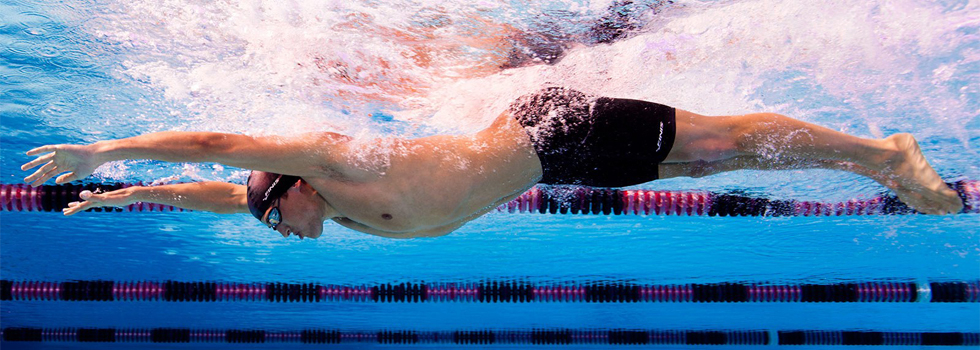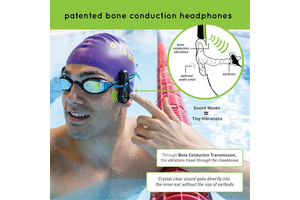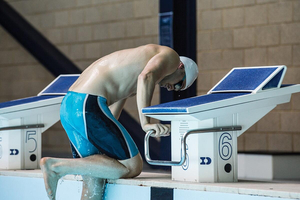Terry Heggy, U.S.Masters Swimming
November 4, 2019
THE RIGHT HEAD POSITION CAN HELP YOU SWIM FASTER AND MORE EFFICIENTLY
The phrase “it’s all in your head” usually refers to the mental aspects of your athletic success. But your head is also a critical factor in the physical side of swimming. It’s relatively large, heavy, and attached to the top of your spine, which means:
- Your head is a major factor in your drag profile.
- Head movement creates momentum in the direction it moves.
- Any head movement in water requires compensatory movement from other body parts.
Having this massive clunky knob above your shoulders wouldn’t be a big deal if it remained stationary. After all, when we put our head down and place our hands together with our arms behind our ears, we can get pretty darned streamlined. Unfortunately, we do have to breathe, so unless we’re swimming backstroke, our head must move.
THE BODY’S STEERING WHEEL
Let’s review some simplified aquatic physics.
- Because your lungs are full of air, they serve as the fulcrum for your balance in the water. Think of your body as a teeter-totter, with your chest being the pivot point.
- Because swimming requires your head to be in front of your spine, it leads the way for the remainder of the body. If your head moves sideways, the spine bends to follow.
- Minimum drag is achieved by a body that is narrow and facing straight in the direction of motion. Any distortion (up, down, sideways) magnifies the drag and dramatically slows forward progress.
If your head goes up, your hips, legs, or feet must press down to compensate. If your head goes sideways, your spine follows, widening your drag profile and forcing you to swim farther as you weave your way down the pool. Just as you control your Ferrari (or in my case, 1978 Pinto) with the steering wheel, you must control the motion of your head for efficient swimming.
IN THE DRIVER’S SEAT
Backstroke and Freestyle
Because your face is exposed to the sweet abundance of oxygen above the water, backstroke requires the least head motion. Indoor swimmers can monitor their head stability by tracking ceiling panels. Outdoor swimmers rely on their kinesthetic senses or feedback from coaches or video. By using this feedback to diagnose and correct head movement driven by improper entry or shoulder-plane imbalances, it should be possible to swim in a very straight line.
Freestylers may experience similar unwanted head movement created by crossover on the catch or misdirected arm pulls. Those can be diagnosed by looking straight down at the lane stripe while you swim without breathing. If the stripe moves, then you’re weaving.
Freestyle breathing can introduce its own problems. Other than vertical head motion implemented to increase applied power, lifting the head or reaching to the side for your breath will adversely distort body position. Correct these issues by ensuring that one goggle lens stays in the water when you breathe (looking straight to the side or slightly back rather than forward), and that the lane stripe is right where you previously saw it when you turn your face back down.
Pay attention to your legs and feet as well. An anomalous kick is frequently the result of an upper-body misalignment. If you kick out to the side or deeper with one leg, it’s probable that the leg motion is an involuntary counterbalance to an unwanted head movement. Fix the head and the legs will get back in line.
Swim a portion of each practice focused strictly on monitoring your head movement. The ability to do it correctly during a single drill does not make it a habit; daily repetition is required to ensure your head stays aligned when it’s race time.
Breaststroke and Butterfly
The undulating motion of butterfly and breaststroke require the head to move vertically, and that’s OK. But you still want to pay attention to that movement and control it for maximum efficiency in your stroke.
Because Masters swimmers vary greatly in flexibility and strength, the “proper” form in undulating strokes varies from athlete to athlete. Some folks find that their most efficient butterfly results from breathing to the side, in which case they can monitor head motion the same way a freestyler would. Those with good spinal flexibility and powerful kick will benefit from an elevated breathing posture to take advantage of head momentum on the forward recovery thrust. But all breaststrokers and butterfliers need to monitor their head to ensure that:
- Head motions stay directly in line with forward motion, eliminating lateral movement.
- Head movement timing results in streamlined arm catch/glide phases of the stroke (e.g., the head is not still lifted up when the arms are stretched forward).
The high energy demands of breaststroke and butterfly tend to lead to stroke deterioration with distance. Awareness of head position as you swim can help you diagnose fatigue flaws creeping into your stroke and take steps to mitigate them. Some seasoned Masters swimmers find success by modifying timing and breathing sequences at the onset of those fatigue warning signs (e.g., flatter body alignment, longer glide on each kick).
Ask your coach for advice on what head movement works best for your body and seek feedback to help you understand what to pay attention to when you monitor yourself as you swim.
HOW TO GET PROPER HEAD POSITION IN ALL FOUR SWIMMING STROKES
Terry Heggy, USMS
November 4, 2019
THE RIGHT HEAD POSITION CAN HELP YOU SWIM FASTER AND MORE EFFICIENTLY
The phrase “it’s all in your head” usually refers to the mental aspects of your athletic success. But your head is also a critical factor in the physical side of swimming. It’s relatively large, heavy, and attached to the top of your spine, which means:
- Your head is a major factor in your drag profile.
- Head movement creates momentum in the direction it moves.
- Any head movement in water requires compensatory movement from other body parts.
Having this massive clunky knob above your shoulders wouldn’t be a big deal if it remained stationary. After all, when we put our head down and place our hands together with our arms behind our ears, we can get pretty darned streamlined. Unfortunately, we do have to breathe, so unless we’re swimming backstroke, our head must move.
THE BODY’S STEERING WHEEL
Let’s review some simplified aquatic physics.
- Because your lungs are full of air, they serve as the fulcrum for your balance in the water. Think of your body as a teeter-totter, with your chest being the pivot point.
- Because swimming requires your head to be in front of your spine, it leads the way for the remainder of the body. If your head moves sideways, the spine bends to follow.
- Minimum drag is achieved by a body that is narrow and facing straight in the direction of motion. Any distortion (up, down, sideways) magnifies the drag and dramatically slows forward progress.
If your head goes up, your hips, legs, or feet must press down to compensate. If your head goes sideways, your spine follows, widening your drag profile and forcing you to swim farther as you weave your way down the pool. Just as you control your Ferrari (or in my case, 1978 Pinto) with the steering wheel, you must control the motion of your head for efficient swimming.
IN THE DRIVER’S SEAT
Backstroke and Freestyle
Because your face is exposed to the sweet abundance of oxygen above the water, backstroke requires the least head motion. Indoor swimmers can monitor their head stability by tracking ceiling panels. Outdoor swimmers rely on their kinesthetic senses or feedback from coaches or video. By using this feedback to diagnose and correct head movement driven by improper entry or shoulder-plane imbalances, it should be possible to swim in a very straight line.
Freestylers may experience similar unwanted head movement created by crossover on the catch or misdirected arm pulls. Those can be diagnosed by looking straight down at the lane stripe while you swim without breathing. If the stripe moves, then you’re weaving.
Freestyle breathing can introduce its own problems. Other than vertical head motion implemented to increase applied power, lifting the head or reaching to the side for your breath will adversely distort body position. Correct these issues by ensuring that one goggle lens stays in the water when you breathe (looking straight to the side or slightly back rather than forward), and that the lane stripe is right where you previously saw it when you turn your face back down.
Pay attention to your legs and feet as well. An anomalous kick is frequently the result of an upper-body misalignment. If you kick out to the side or deeper with one leg, it’s probable that the leg motion is an involuntary counterbalance to an unwanted head movement. Fix the head and the legs will get back in line.
Swim a portion of each practice focused strictly on monitoring your head movement. The ability to do it correctly during a single drill does not make it a habit; daily repetition is required to ensure your head stays aligned when it’s race time.
Breaststroke and Butterfly
The undulating motion of butterfly and breaststroke require the head to move vertically, and that’s OK. But you still want to pay attention to that movement and control it for maximum efficiency in your stroke.
Because Masters swimmers vary greatly in flexibility and strength, the “proper” form in undulating strokes varies from athlete to athlete. Some folks find that their most efficient butterfly results from breathing to the side, in which case they can monitor head motion the same way a freestyler would. Those with good spinal flexibility and powerful kick will benefit from an elevated breathing posture to take advantage of head momentum on the forward recovery thrust. But all breaststrokers and butterfliers need to monitor their head to ensure that:
- Head motions stay directly in line with forward motion, eliminating lateral movement.
- Head movement timing results in streamlined arm catch/glide phases of the stroke (e.g., the head is not still lifted up when the arms are stretched forward).
The high energy demands of breaststroke and butterfly tend to lead to stroke deterioration with distance. Awareness of head position as you swim can help you diagnose fatigue flaws creeping into your stroke and take steps to mitigate them. Some seasoned Masters swimmers find success by modifying timing and breathing sequences at the onset of those fatigue warning signs (e.g., flatter body alignment, longer glide on each kick).
Ask your coach for advice on what head movement works best for your body and seek feedback to help you understand what to pay attention to when you monitor yourself as you swim.
Terry Heggy, USMS
November 4, 2019
THE RIGHT HEAD POSITION CAN HELP YOU SWIM FASTER AND MORE EFFICIENTLY
The phrase “it’s all in your head” usually refers to the mental aspects of your athletic success. But your head is also a critical factor in the physical side of swimming. It’s relatively large, heavy, and attached to the top of your spine, which means:
- Your head is a major factor in your drag profile.
- Head movement creates momentum in the direction it moves.
- Any head movement in water requires compensatory movement from other body parts.
Having this massive clunky knob above your shoulders wouldn’t be a big deal if it remained stationary. After all, when we put our head down and place our hands together with our arms behind our ears, we can get pretty darned streamlined. Unfortunately, we do have to breathe, so unless we’re swimming backstroke, our head must move.
THE BODY’S STEERING WHEEL
Let’s review some simplified aquatic physics.
- Because your lungs are full of air, they serve as the fulcrum for your balance in the water. Think of your body as a teeter-totter, with your chest being the pivot point.
- Because swimming requires your head to be in front of your spine, it leads the way for the remainder of the body. If your head moves sideways, the spine bends to follow.
- Minimum drag is achieved by a body that is narrow and facing straight in the direction of motion. Any distortion (up, down, sideways) magnifies the drag and dramatically slows forward progress.
If your head goes up, your hips, legs, or feet must press down to compensate. If your head goes sideways, your spine follows, widening your drag profile and forcing you to swim farther as you weave your way down the pool. Just as you control your Ferrari (or in my case, 1978 Pinto) with the steering wheel, you must control the motion of your head for efficient swimming.
IN THE DRIVER’S SEAT
Backstroke and Freestyle
Because your face is exposed to the sweet abundance of oxygen above the water, backstroke requires the least head motion. Indoor swimmers can monitor their head stability by tracking ceiling panels. Outdoor swimmers rely on their kinesthetic senses or feedback from coaches or video. By using this feedback to diagnose and correct head movement driven by improper entry or shoulder-plane imbalances, it should be possible to swim in a very straight line.
Freestylers may experience similar unwanted head movement created by crossover on the catch or misdirected arm pulls. Those can be diagnosed by looking straight down at the lane stripe while you swim without breathing. If the stripe moves, then you’re weaving.
Freestyle breathing can introduce its own problems. Other than vertical head motion implemented to increase applied power, lifting the head or reaching to the side for your breath will adversely distort body position. Correct these issues by ensuring that one goggle lens stays in the water when you breathe (looking straight to the side or slightly back rather than forward), and that the lane stripe is right where you previously saw it when you turn your face back down.
Pay attention to your legs and feet as well. An anomalous kick is frequently the result of an upper-body misalignment. If you kick out to the side or deeper with one leg, it’s probable that the leg motion is an involuntary counterbalance to an unwanted head movement. Fix the head and the legs will get back in line.
Swim a portion of each practice focused strictly on monitoring your head movement. The ability to do it correctly during a single drill does not make it a habit; daily repetition is required to ensure your head stays aligned when it’s race time.
Breaststroke and Butterfly
The undulating motion of butterfly and breaststroke require the head to move vertically, and that’s OK. But you still want to pay attention to that movement and control it for maximum efficiency in your stroke.
Because Masters swimmers vary greatly in flexibility and strength, the “proper” form in undulating strokes varies from athlete to athlete. Some folks find that their most efficient butterfly results from breathing to the side, in which case they can monitor head motion the same way a freestyler would. Those with good spinal flexibility and powerful kick will benefit from an elevated breathing posture to take advantage of head momentum on the forward recovery thrust. But all breaststrokers and butterfliers need to monitor their head to ensure that:
- Head motions stay directly in line with forward motion, eliminating lateral movement.
- Head movement timing results in streamlined arm catch/glide phases of the stroke (e.g., the head is not still lifted up when the arms are stretched forward).
The high energy demands of breaststroke and butterfly tend to lead to stroke deterioration with distance. Awareness of head position as you swim can help you diagnose fatigue flaws creeping into your stroke and take steps to mitigate them. Some seasoned Masters swimmers find success by modifying timing and breathing sequences at the onset of those fatigue warning signs (e.g., flatter body alignment, longer glide on each kick).
Ask your coach for advice on what head movement works best for your body and seek feedback to help you understand what to pay attention to when you monitor yourself as you swim.



















